The nature of fashion is change and it doesn't move much quicker than in Ximending, where Taipei's hipsters swell the crowds and seek out the latest trends, whether it's clothes, arcade games or music. Shops that are out of fashion shut down one day and open up the next catering to the latest fad, smelling of sawed wood, glue and paint.
"Crystal nails" are in at the moment.
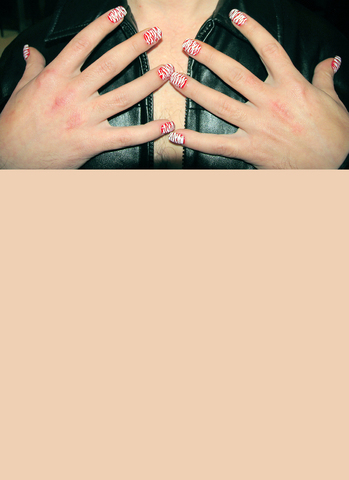
Tattoos are out and parlors are going out of business. In their place, small salons are springing up that offer crystal nail extensions made of acrylic, in a rainbow of glossy colors, a geometry set of shapes and styles. Women sit around tables chatting, sipping tea perhaps and are seemingly idle, but in fact they are busy discussing what set of nails are best suited to a wedding, or how to look after them once they are applied.
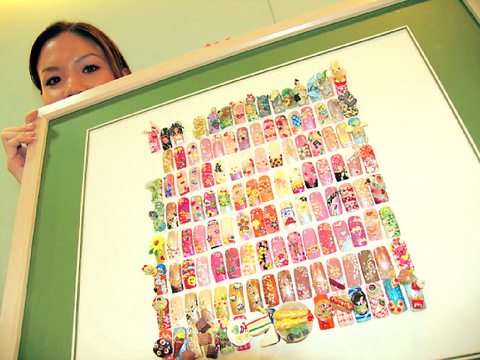
PHOTO: JULES QUARTLY, TAIPEI TIMES
"This is the latest trend," one nail-painting saleswoman in Ximending says, with the enthusiasm of someone who has discovered something important. "All women want to be beautiful and after taking care of your body, hair and skin, this is a good way to stand out from the crowd. Now everyone can have good nails."
Women probably started painting their nails as soon as they discovered them, but the first recorded instances of them doing so are are said to be in China 5,000 years ago. In the Ming dynasty (1368 to 1644) nail color indicated social status and the empress' fingernails were red and black. In Rome and Egypt military men painted their nails before a battle.
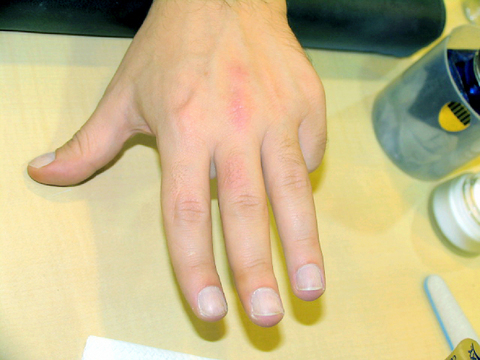
PHOTO: JULES QUARTLY, TAIPEI TIMES
Today, it's the US that leads and acrylic nails were developed there in the 1970s, arriving in Japan 15 years ago. "Our background was in beauty care and hair and we introduced crystal nails about eight years ago," says Hu Xi-qin (
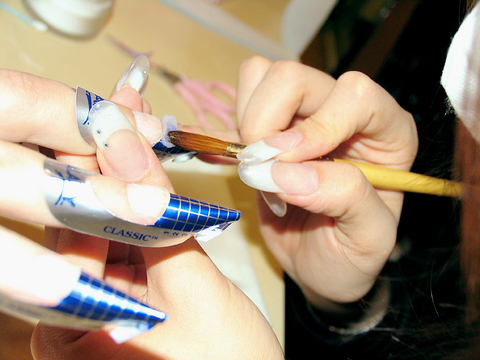
PHOTO: JULES QUARTLY, TAIPEI TIMES
Hu says the reason for the increasing popularity of nail extensions is the upturn in the economy, more leisure time for women and changes in the workplace, meaning most jobs now do not involve hard manual labor and therefore broken nails. Also, fake nails used to be stuck to the tips or over the nail and could look ungainly and were liable to fall off. The new method is to build an acrylic extension to the nail, which looks and feels natural.
Kari Share employee Rina Zhou (
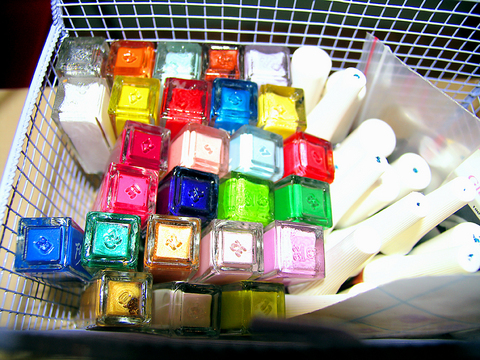
PHOTO: JULES QUARTLY, TAIPEI TIMES
Our model for the day at Kari Share is Cobus du Plessis, an editor at the Taipei Times, who is encouraged by his girlfriend to find out what hard work beauty can be. His trained nail technician is Lin Fang-wen (林方玟), who has been at Kari Share for six years and helps run training sessions for the 40 employees gathered at the company headquarters on Chengde Road. She says most of her
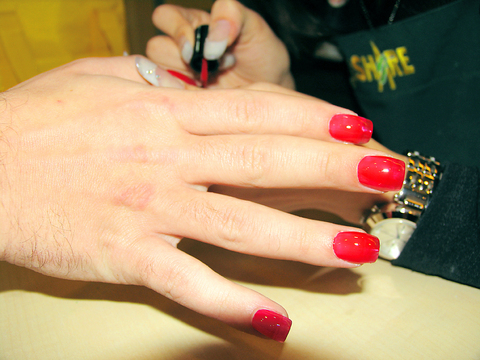
PHOTO: JULES QUARTLY, TAIPEI TIMES
customers are young, but not necessarily. She says they are not all women, either. "We see quite a few transvestites."
"People have different reasons for getting their nails done. It helps them feel better and more beautiful. It's also good to go with friends so that you can talk and compare. I like painting, so I like the job. Also, we can gossip and sometimes our customers become our friends," Lin says.
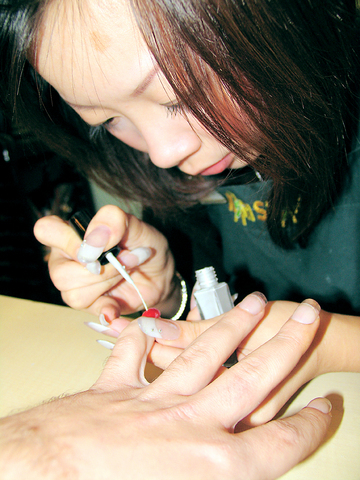
PHOTO: JULES QUARTLY, TAIPEI TIMES
Needless to say, there is some polite amusement as the foreigner with large and hairy fingers settles down for his manicure and nail painting.
First, Lin cleans and exfoliates with an emery board before putting on 10 paper molds on each finger, just under the nails and extending outward. Then an ethanol solution is applied to clean and balance the PH of the nails, dehydrate and sterilize. The primer will maximize adhesion of the acrylic. Lin dips her calligraphy brush into a solvent and dabs it into some white acrylic powder, before spreading the resultant paste over the nail and paper mold. As it dries and then hardens, she squeezes the acrylic into shape and Du Plessis complains a little that this is uncomfortable. She tells him to relax.
When the acrylic is completely dry, Lin gets out the emery board again and a grinder to work and shape the nail into its final form. After washing his hands, it appears that our model has a perfectly natural set of nails, just longer than before. The painting operation begins and a lush red undercoat is applied. Then another coat, until it is a glossy, bright enamel. It's now two-and-a-half hours into the operation and our model is tiring and desperate for a fag. But the beauty show must go on.
Lin deftly brushes white tiger stripes over the red enamel, but tuts a little when Du Plessis moves his hands to get the circulation going. There is a small smudge, so she goes back a step, wipes off the nail paint and reapplies. Half an hour later the operation is over.
Semiprecious stones, stencils, "twinkle flowers," stickers, sponge-pen work, aerosol spray and acrylic-colored birds or other objects are further options, but Du Plessis, who has been a model of patience, is ready to roll.
"They're harder than nails," he reports the next day. "They take a bit of getting used to, especially for delicate tasks. Even picking up a pen is kind of tricky. You have to relearn how to do things."
"But they are strong," he reiterates. "I carried a sofa up a narrow flight of stairs when I got home and the nails were unscathed ... The big thing is to let the the nails dry after they're done otherwise stuff sticks to them and they get kind of dull. They're certainly attention grabbers."
If the nails are properly dried after being painted the enamel polish lasts at least two to three weeks without chipping or picking up fluff. Most people return to the salon around this time as the nail grows and a depression appears between the acrylic and the real nail, which needs filling. Also, the nail can be damaged when exposed to water, which can lead to a fungus infection, though this is rare. Finally, the real nail can be weakened when the extension is removed, but a trained technician will be able to advise.

June 2 to June 8 Taiwan’s woodcutters believe that if they see even one speck of red in their cooked rice, no matter how small, an accident is going to happen. Peng Chin-tian (彭錦田) swears that this has proven to be true at every stop during his decades-long career in the logging industry. Along with mining, timber harvesting was once considered the most dangerous profession in Taiwan. Not only were mishaps common during all stages of processing, it was difficult to transport the injured to get medical treatment. Many died during the arduous journey. Peng recounts some of his accidents in

“Why does Taiwan identity decline?”a group of researchers lead by University of Nevada political scientist Austin Wang (王宏恩) asked in a recent paper. After all, it is not difficult to explain the rise in Taiwanese identity after the early 1990s. But no model predicted its decline during the 2016-2018 period, they say. After testing various alternative explanations, Wang et al argue that the fall-off in Taiwanese identity during that period is related to voter hedging based on the performance of the Democratic Progressive Party (DPP). Since the DPP is perceived as the guardian of Taiwan identity, when it performs well,

The Taiwan People’s Party (TPP) on May 18 held a rally in Taichung to mark the anniversary of President William Lai’s (賴清德) inauguration on May 20. The title of the rally could be loosely translated to “May 18 recall fraudulent goods” (518退貨ㄌㄨㄚˋ!). Unlike in English, where the terms are the same, “recall” (退貨) in this context refers to product recalls due to damaged, defective or fraudulent merchandise, not the political recalls (罷免) currently dominating the headlines. I attended the rally to determine if the impression was correct that the TPP under party Chairman Huang Kuo-Chang (黃國昌) had little of a

At Computex 2025, Nvidia CEO Jensen Huang (黃仁勳) urged the government to subsidize AI. “All schools in Taiwan must integrate AI into their curricula,” he declared. A few months earlier, he said, “If I were a student today, I’d immediately start using tools like ChatGPT, Gemini Pro and Grok to learn, write and accelerate my thinking.” Huang sees the AI-bullet train leaving the station. And as one of its drivers, he’s worried about youth not getting on board — bad for their careers, and bad for his workforce. As a semiconductor supply-chain powerhouse and AI hub wannabe, Taiwan is seeing